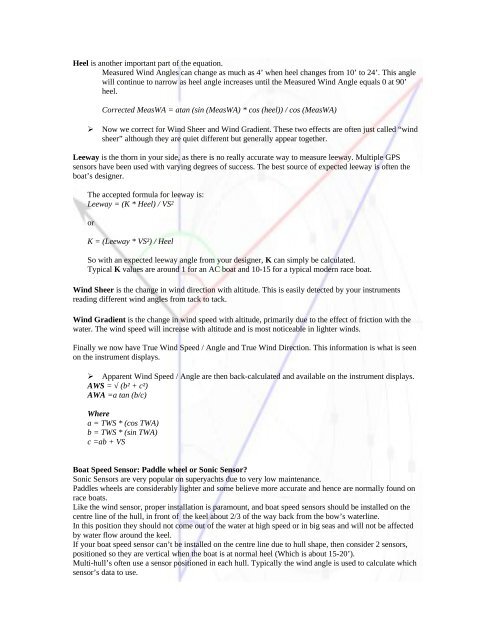Race boat instruments â understanding it all - L-36 Fleet
Race boat instruments â understanding it all - L-36 Fleet
Race boat instruments â understanding it all - L-36 Fleet
You also want an ePaper? Increase the reach of your titles
YUMPU automatically turns print PDFs into web optimized ePapers that Google loves.
Heel is another important part of the equation.Measured Wind Angles can change as much as 4’ when heel changes from 10’ to 24’. This anglewill continue to narrow as heel angle increases until the Measured Wind Angle equals 0 at 90’heel.Corrected MeasWA = atan (sin (MeasWA) * cos (heel)) / cos (MeasWA)Now we correct for Wind Sheer and Wind Gradient. These two effects are often just c<strong>all</strong>ed “windsheer” although they are quiet different but gener<strong>all</strong>y appear together.Leeway is the thorn in your side, as there is no re<strong>all</strong>y accurate way to measure leeway. Multiple GPSsensors have been used w<strong>it</strong>h varying degrees of success. The best source of expected leeway is often the<strong>boat</strong>’s designer.The accepted formula for leeway is:Leeway = (K * Heel) / VS²orK = (Leeway * VS²) / HeelSo w<strong>it</strong>h an expected leeway angle from your designer, K can simply be calculated.Typical K values are around 1 for an AC <strong>boat</strong> and 10-15 for a typical modern race <strong>boat</strong>.Wind Sheer is the change in wind direction w<strong>it</strong>h alt<strong>it</strong>ude. This is easily detected by your <strong>instruments</strong>reading different wind angles from tack to tack.Wind Gradient is the change in wind speed w<strong>it</strong>h alt<strong>it</strong>ude, primarily due to the effect of friction w<strong>it</strong>h thewater. The wind speed will increase w<strong>it</strong>h alt<strong>it</strong>ude and is most noticeable in lighter winds.Fin<strong>all</strong>y we now have True Wind Speed / Angle and True Wind Direction. This information is what is seenon the instrument displays. Apparent Wind Speed / Angle are then back-calculated and available on the instrument displays.AWS = √ (b² + c²)AWA =a tan (b/c)Wherea = TWS * (cos TWA)b = TWS * (sin TWA)c =ab + VSBoat Speed Sensor: Paddle wheel or Sonic Sensor?Sonic Sensors are very popular on superyachts due to very low maintenance.Paddles wheels are considerably lighter and some believe more accurate and hence are norm<strong>all</strong>y found onrace <strong>boat</strong>s.Like the wind sensor, proper inst<strong>all</strong>ation is paramount, and <strong>boat</strong> speed sensors should be inst<strong>all</strong>ed on thecentre line of the hull, in front of the keel about 2/3 of the way back from the bow’s waterline.In this pos<strong>it</strong>ion they should not come out of the water at high speed or in big seas and will not be affectedby water flow around the keel.If your <strong>boat</strong> speed sensor can’t be inst<strong>all</strong>ed on the centre line due to hull shape, then consider 2 sensors,pos<strong>it</strong>ioned so they are vertical when the <strong>boat</strong> is at normal heel (Which is about 15-20’).Multi-hull’s often use a sensor pos<strong>it</strong>ioned in each hull. Typic<strong>all</strong>y the wind angle is used to calculate whichsensor’s data to use.
















